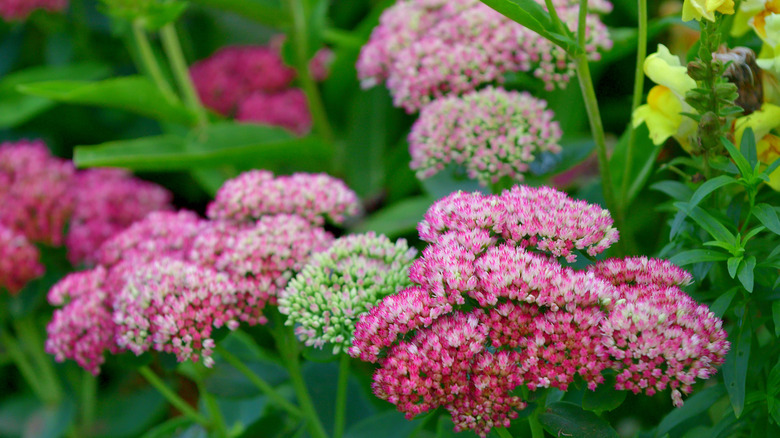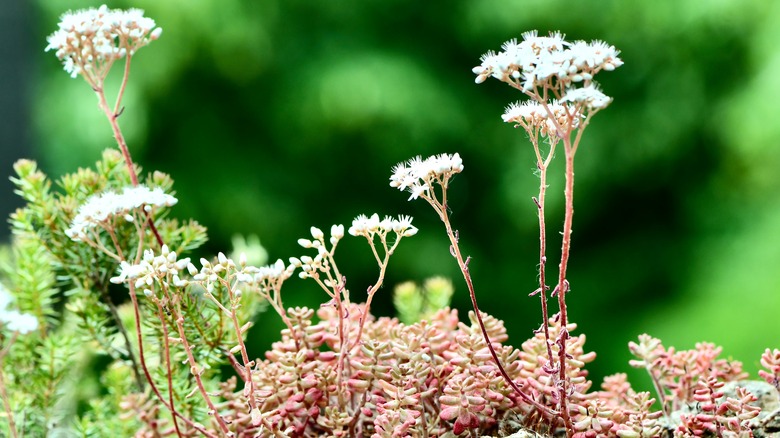Try This Trick To Make Your Sedum Plants Fuller And Longer-Blooming
Sedums, commonly known as stonecrop, are hardy plants famed for their attractive, fleshy foliage and ability to enhance your drought-friendly lawn. Members of the Crassulaceae family, these stunning flowers make the perfect ground cover for year round color in your garden. With several types available, they're a popular species for many, including pollinators like butterflies and bees. Whether mat-forming, creeping, or upright sedums, you may need to make a few tweaks to make your leggy plants fuller and produce more blooms. When plants are lanky and falling over, or worse, not blooming to their full potential, it not only creates an unsightly appearance but also poses obstacles for your beloved nectar sippers.
Sometimes, all your sedums need is a little haircut, which may seem counterproductive at first. However, they'll reward you with more compact growth and increased blooms when they grow back. We'll go over where to cut and how often to trim back your plant to give you the best chance at having lush, vibrant foliage and more flowering. Aside from snipping your sedums, make sure they receive sufficient sunlight. As succulents, these tropical growers need a lot of light to get the energy they need to produce blooms, so make sure they're in an area that receives full sun. Sedums don't ask for much to grow happy and healthy, and with the right care (and a few tips and tricks), your plants will bloom through autumn.
Pinch back sedums for a fuller plant
To encourage new blooms and have bushier growth, use your fingers or a sanitized pair of gardening shears to remove up to half the height of the stem. Aim for a spot near the next set of leaves. The best time to trim stonecrops is in late spring to early summer, though you can remove dead foliage and deadhead spent flowers any time of the year. With each healthy stem you pinch back, several new stems will emerge in its place. Even better, the new shoots growing beneath the cut will be shorter, giving you more compact growth and more flower buds. However, it's best to avoid pruning during cold winters or extremely hot periods when your plants are the most stressed.
Whether you're using stonecrop as a ground cover to prevent pesky weeds in the garden or as a trailing plant cascading down a hanging basket, you may want to try staggering your cuts. Although there aren't any studies backing this claim, some anecdotal evidence suggests this trick can extend the blooming period. Basically, you'll cut a small section of your plant each week or so. The first chunk you pinch will grow and bloom first, and the others will follow suit over the following weeks. Sedums are forgiving and this process won't harm your plants, so it's worth giving it a shot! Give your plant some time to redirect its energy to the new growth, as this process can delay flowering.
Other tricks to keep sedums blooming beautifully
In addition to pinching back, pruning your sedums can be beneficial. For taller varieties, you can either cut the entire plant back once the first frost hits or keep the foliage around as an eye-catching addition to your winter landscape. While cutting back your plants can effectively help maintain their shape and encourage more blooming, it can only do so much if there are underlying issues. Overwatering is a common problem for these dry-loving succulents. Sedums use their leaves for water storage and only need watering during extreme drought. They should be in well-drained soil, as compact soils can lead to deadly root rot. Additionally, overwatering upright varieties may cause them to flop.
With most flowers, fertilizer is the key ingredient if you want your plants to produce more blooms. Stonecrop, however, feels a bit more at home when living in poor soils, and too much food can have the opposite effect, as nitrogen-rich soil can cause your stonecrop to produce fewer blooms. Fertilized sedums will produce long, leggy stems that aren't strong enough to hold up their flowers, causing them to droop. Although sedums do fine without any fertilization, you can feed them a balanced, slow-release fertilizer in spring, then hold off the rest of the year. A neglected stonecrop is a happy stonecrop, so err on the side of less feedings and watering, and your plants will happily grow in a sunny spot in your garden.


